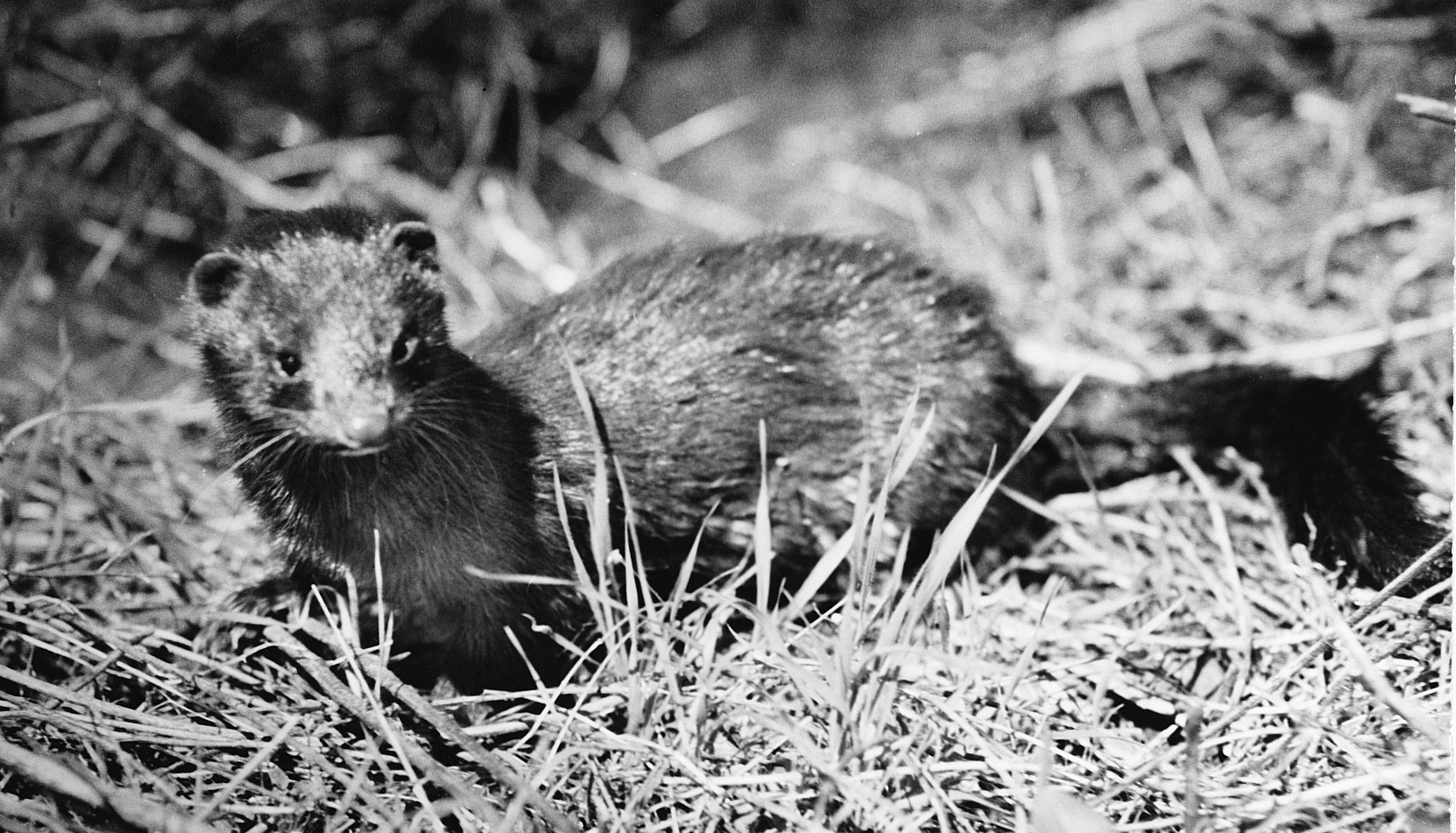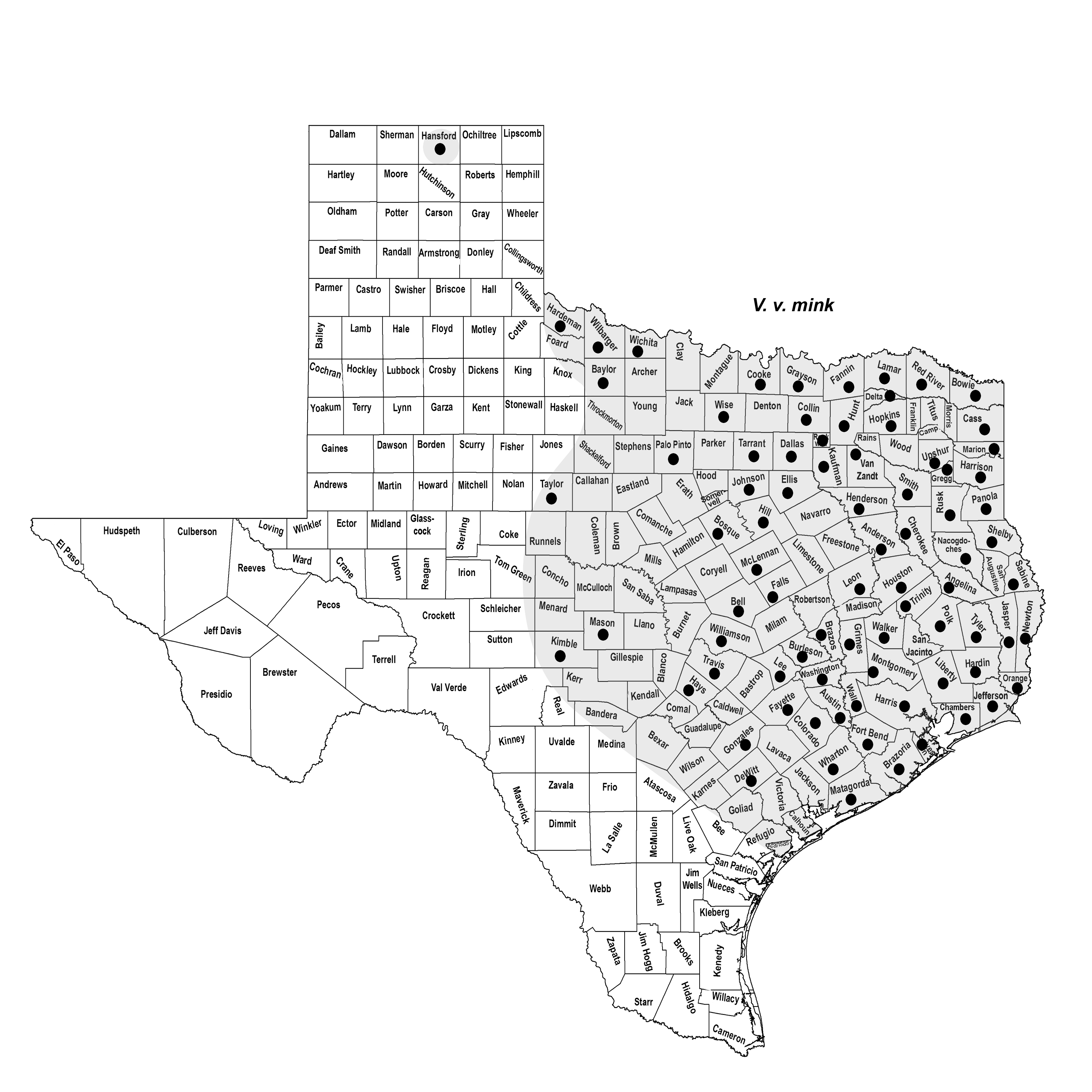AMERICAN MINK
Vison vison Schreber 1777
Order Carnivora : Family Mustelidae
DESCRIPTION. A weasel-like carnivore about the size of a house cat and semiaquatic in habit; general color dark chocolate brown, darkest on back, and nearly black on feet and end of tail; underparts paler than back, with considerable white on midline from chin to vent; neck long, head hardly larger around than neck; tail long and moderately bushy; eyes and ears small; legs short; pelage soft and dense, overlaid with longer, blackish guard hairs. Dental formula: I 3/3, C 1/1, Pm 3/3, M 1/2 × 2 = 34. External measurements of an adult male: total length, 560 mm; tail, 190 mm; hind foot, 67 mm; of a female, 540-180-60 mm. Weight of males, 680–1,300 g; of females, 450–700 g.

DISTRIBUTION. Known from eastern one-half of state and one county in the northern Panhandle. Found only in habitats near permanent water.

SUBSPECIES. Vison v. mink.
HABITS. American mink are semiaquatic mammals. Their thick underfur prevents water from penetrating to the skin, and the toes of the hind feet are slightly webbed. They swim well enough to catch fish, and they can remain submerged for considerable periods of time. Mink live in dens located near water in such places as natural rock crevices or cavities among rocks, at the bases of bridges or dams, under roots of trees, in holes in the banks of streams, in debris piled along streams, or in muskrat homes.
Mink are active all year and do not hibernate. They are mainly nocturnal but often appear at dawn and dusk and less frequently during the day. They are not social animals and live alone except when the young are being raised. The territories of males overlap, and several males may use various dens in succession. Females usually occupy only one den site during the year.
American mink produce one litter each year in the spring. Males are polygamous, but they generally stay with the last female bred to assist in rearing the young. Mating occurs from January to March. Delayed implantation is exhibited, with birth occurring about 30 days after implantation. The total gestation period ranges from 40 to 75 days (average 51 days). A typical litter contains 3–4 kits, but litters of over 10 have been recorded.
Kits are about 100 mm long at birth and weigh about 6 g. They are born blind, helpless, and covered with a coat of fine, short, silvery white hair. The coat color changes to reddish brown in about 14 days, and the eyes open at 37 days. The young leave the nest for the first time at 7 weeks and are weaned at 8–9 weeks. The family stays together until the end of August.
Their diet varies seasonally; crayfish and some mammals and frogs make up most of the summer diet, and small mammals are the major food item in winter. Mammals eaten by mink include shrews, moles, bats, rats and mice, squirrels, and young muskrats.
Mink seldom live >1.5–2 years in the wild. They have few predators other than humans, but young animals may fall victim to bobcats, coyotes, dogs, foxes, owls, and alligators in coastal marshes.
Historically, the American mink was one of the principal fur-bearing animals in the eastern United States and is one of the few animals that can be reared economically on fur farms. This is not the case in Texas, however, where mink ranked only 13th both in numbers of individuals harvested during the 2001–2002 trapping season, as determined in a survey conducted by TPWD.
American mink were placed in the genus Mustela; however, recent karyotypic and biochemical data were used to place the American mink in a separate genus (Vison). Therefore, references to mink, especially in older literature, may be found under Mustela vison.
POPULATION STATUS. Uncommon. The American mink is another species that appears to be declining as a result of the reduction of natural surface water across the state. It has declined in abundance since the twentieth century and does not appear to be common anywhere in Texas.
CONSERVATION STATUS. The IUCN lists the American mink as a species of least concern, and it does not appear on the federal or state lists of concerned species. Based on its uncommon and rare status across the state, this species should be carefully monitored in the future.
From The Mammals of Texas, Seventh Edition by David J. Schmidly and Robert D. Bradley, copyright © 1994, 2004, 2016. Courtesy of the University of Texas Press.
Natural Science Research Laboratory
-
Address
Museum of Texas Tech University, 3301 4th street, Lubbock, TX 79409 -
Phone
806.742.2486 -
Email
nsrl.museum@ttu.edu

